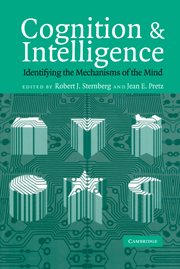Book contents
- Frontmatter
- Contents
- Preface
- 1 Information Processing and Intelligence: Where We Are and Where We Are Going
- 2 Mental Chronometry and the Unification of Differential Psychology
- 3 Reductionism versus Charting: Ways of Examining the Role of Lower-Order Cognitive Processes in Intelligence
- 4 Basic Information Processing and the Psychophysiology of Intelligence
- 5 The Neural Bases of Intelligence: A Perspective Based on Functional Neuroimaging
- 6 The Role of Working Memory in Higher-Level Cognition: Domain-Specific versus Domain-General Perspectives
- 7 Higher-Order Cognition and Intelligence
- 8 Ability Determinants of Individual Differences in Skilled Performance
- 9 Complex Problem Solving and Intelligence: Empirical Relation and Causal Direction
- 10 Intelligence as Smart Heuristics
- 11 The Role of Transferable Knowledge in Intelligence
- 12 Reasoning Abilities
- 13 Measuring Human Intelligence with Artificial Intelligence: Adaptive Item Generation
- 14 Marrying Intelligence and Cognition: A Developmental View
- 15 From Description to Explanation in Cognitive Aging
- 16 Unifying the Field: Cognition and Intelligence
- Author Index
- Subject Index
- References
5 - The Neural Bases of Intelligence: A Perspective Based on Functional Neuroimaging
Published online by Cambridge University Press: 23 November 2009
- Frontmatter
- Contents
- Preface
- 1 Information Processing and Intelligence: Where We Are and Where We Are Going
- 2 Mental Chronometry and the Unification of Differential Psychology
- 3 Reductionism versus Charting: Ways of Examining the Role of Lower-Order Cognitive Processes in Intelligence
- 4 Basic Information Processing and the Psychophysiology of Intelligence
- 5 The Neural Bases of Intelligence: A Perspective Based on Functional Neuroimaging
- 6 The Role of Working Memory in Higher-Level Cognition: Domain-Specific versus Domain-General Perspectives
- 7 Higher-Order Cognition and Intelligence
- 8 Ability Determinants of Individual Differences in Skilled Performance
- 9 Complex Problem Solving and Intelligence: Empirical Relation and Causal Direction
- 10 Intelligence as Smart Heuristics
- 11 The Role of Transferable Knowledge in Intelligence
- 12 Reasoning Abilities
- 13 Measuring Human Intelligence with Artificial Intelligence: Adaptive Item Generation
- 14 Marrying Intelligence and Cognition: A Developmental View
- 15 From Description to Explanation in Cognitive Aging
- 16 Unifying the Field: Cognition and Intelligence
- Author Index
- Subject Index
- References
Summary
INTRODUCTION
The study of intelligence has provided two major and enduring contributions to the understanding of human thought: a comprehensive characterization of human intelligence and a method to measure the variation in intelligence among individuals. These contributions have been based almost exclusively on behavioral measures of intelligence, using primarily paper-and-pencil tests. The development of brain imaging technology at the end of the twentieth century provided the ability to measure brain activity in individuals during the performance of tasks like those that compose intelligence tests. These brain imaging measures have the potential of providing a new and possibly more comprehensive view of intelligence as well as providing insight into the basis of individual differences. In this chapter, we sketch the very beginnings of this approach to intelligence that may provide a new comprehensive characterization of intelligence enriched by insights from recent brain imaging findings. This novel approach may also provide suggestions of methods to measure individual differences.
Intelligence is difficult to define, and in fact, there is little consensus among scientific researchers as to what is meant by intelligence (Jensen, 1998). A general definition provided by Sternberg and Salter (1982) that we will use is “goal-directed adaptive behavior.” Intelligent behavior is adaptive in that it changes to confront and effectively meet challenges. Because it is not enough for intelligent behavior to simply be adaptive, it is also thought to be goal-directed, or purposeful. However, it is the adaptive nature of intelligence that will be the primary focus of this chapter.
- Type
- Chapter
- Information
- Cognition and IntelligenceIdentifying the Mechanisms of the Mind, pp. 88 - 103Publisher: Cambridge University PressPrint publication year: 2004

